Crampons. Where to even begin? Crampons are an essential piece of winter kit for those who enjoy adventuring on ice and snow, whether climbing up an icy gulley or trekking across a snow-covered peak. But it’s important to wear the correct crampons and pair them with the right boots.
Why? Well, in severe situations, it could be a matter of catastrophe, but generally, it’ll help prevent accidents and likely contribute to how much enjoyment you get from your adventure.
Let’s start by going back to basics.
What Are Crampons, and What Are They Used For?
Crampons are a set of metal spikes that you attach to your boots to improve mobility and traction on snow and ice. They’re often made from steel or aluminum and have a varying number of spikes on the bottom, tailored to different uses.
People often use crampons for hiking and trekking in freezing conditions, crossing glaciers, ski touring, ice climbing and winter mountaineering. They come in various weights and materials, each with their own pros and cons.
Steel vs aluminium crampons
Steel is preferred, due to its strength, although this option does weigh more. Aluminum is becoming more common, but generally isn’t suited to sparse UK conditions, where you’re more likely to kick a rock than a snowball, as this is where aluminum has the potential to break – not good for safety, or your bank balance!
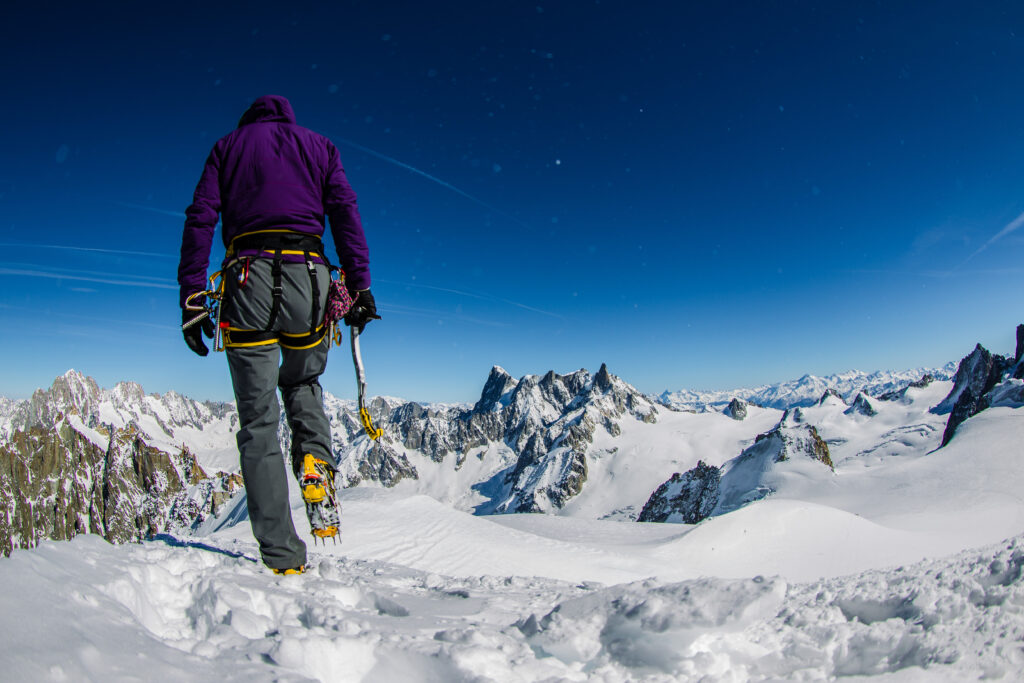
The Anatomy Of A Crampon
Crampons have a front section and a heel section, joined by a bar in the middle. The more flexible the bar, the better suited to walking it is. The stiffer the bar, the better suited to climbing it is. These bars have holes which allow adjustability for accommodating different sized boots.
They also have spikes, and right underneath your toe are the front points of the crampon. Short horizontal points are better suited to walking, whilst long horizontal points are better suited to mountaineering and sharp vertical points to climbing. It’s also worth noting that the more spikes on the front section, the better suited to technical mountaineering they are.
Anti-balling plates
Underneath you’ll see plastic plates called anti-balling plates. Anti-balling plates aim to stop snow from freezing to the exposed metal on the underside of the crampons. Otherwise, without these plates, snowballs could potentially under your feet, rendering the points of the crampons useless. These plates also aim to stop snow from becoming compacted in-between the crampon and the boot, which has the potential to knock the crampon off altogether.
On the top of the crampons, you may notice differing methods for attaching them to your boots.
Strap-on crampons
Strap-on crampons feature plastic baskets at the heel and toe, joined with a strap to hold them in place. These are the most versatile, but least secure, providing a good option for walkers, although not the durability required for climbing and mountaineering.
Semi-automatic crampons
Semi-automatic crampons have a plastic toe basket and a heel clamp, with straps between them to hold them in place. This design gives the best all-round performance and offers security, as well as adjustability, when used with compatible boots.
Automatic crampons
Automatic crampons feature metal toe bails and heel clamps. They offer the most durable and secure fit when used with the right footwear.
Microspikes
Microspikes, or pavement crampons, are becoming increasingly popular. They’re great when used for their intended purpose – to gain traction over flatter, icy ground. However, they can be less effective on steeper paths, or even on slightly angled side slopes, as the only thing attaching them to your boots is some stretchy elastomer. This is because the flexibility of this elastomer makes it easy for your boot to slip out of the crampon.
Microspikes also lack the anti-balling functionality underneath, meaning in sticky snow, you spend more time knocking the snowballs off the bottom than you do walking.
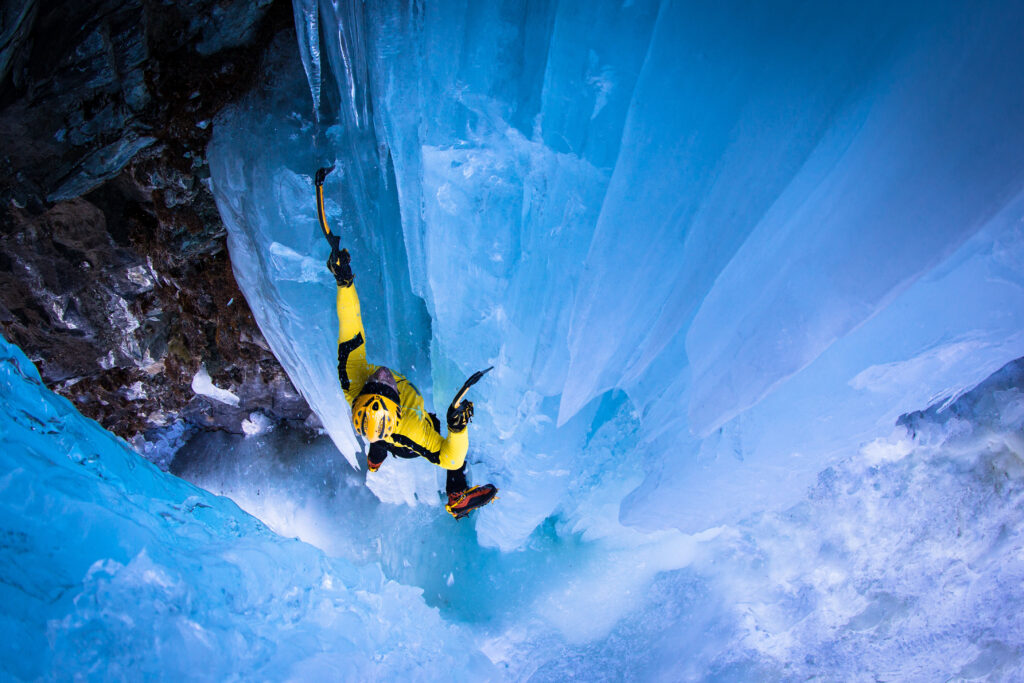
Rating Systems
Neither crampons nor boots have a common rating system, either for stiffness or intended use, particularly across brands. However, labels often design boots with a particular use in mind. The requirements for a winter walker’s boot and crampon combination are very different to the needs of either a Ski Tourer or Ice Climber, for example.
To help differentiate between the sort of rigours that you’ll be putting the boots and crampons under, you’ll often hear of a system that uses B-ratings for boots and C-ratings for crampons. These letters are followed by either 1,2 or 3, denoting the stiffness of the product, 1 being more flexible, and 3 being less flexible. Each rating allows you to decipher which crampons and boots are suitable for certain activities, and which crampons need pairing with which boots.
In terms of ratings, it’s worth starting with your footwear, as your boots will indicate what crampons are suitable for use with them.
Boot Ratings
B0 boots
Consider a B0 boot to be the stiffest walking boot you can find. They generally possess a thick, full-grain upper, a full rubber or TPU rand, and a deep, well-spaced rubber tread. If you took the boot in your hands and tried to bend the toe to meet the heel, you’ll barely be able to bend it. Any boots less robust than this, with more flexible midsoles and uppers, are generally designed for hill walking and hiking below the snow line. If paired with a crampon, these flexible boots run the risk of popping out of place, a potentially dangerous situation if you slip or trip up. Therefore, B0 boots are suitable for pairing with microspikes on flatter easier ground, to prevent slips in icy conditions.
B1 boots
B1 boots are designed for four-season use and can be worn for hiking, trekking, scrambling or less technical winter walks. They take the points from B0 boots, and turn the dial up to 11. B1 boots have a stiffer midsole and chunkier tread on the outsole.
You’ll often find a more walking-orientated tread pattern on a B1 boot, when compared to some of its more winter-mountaineering-focused cousins. They also have a good amount of ‘rocker’ to allow a natural gait when walking. Manufacturers often combine these features with leather or fabric uppers that provide ample protection and durability. Walking-focused models sometimes include insulation, too.
Finding a TPU heel ledge for additional, secure crampon compatibility is becoming more common, especially in climbing-focused models. You should wear B1-rated boots with C1 crampons. This pairing will work perfectly for most UK winter fell walks and gentle adventures in the snow.
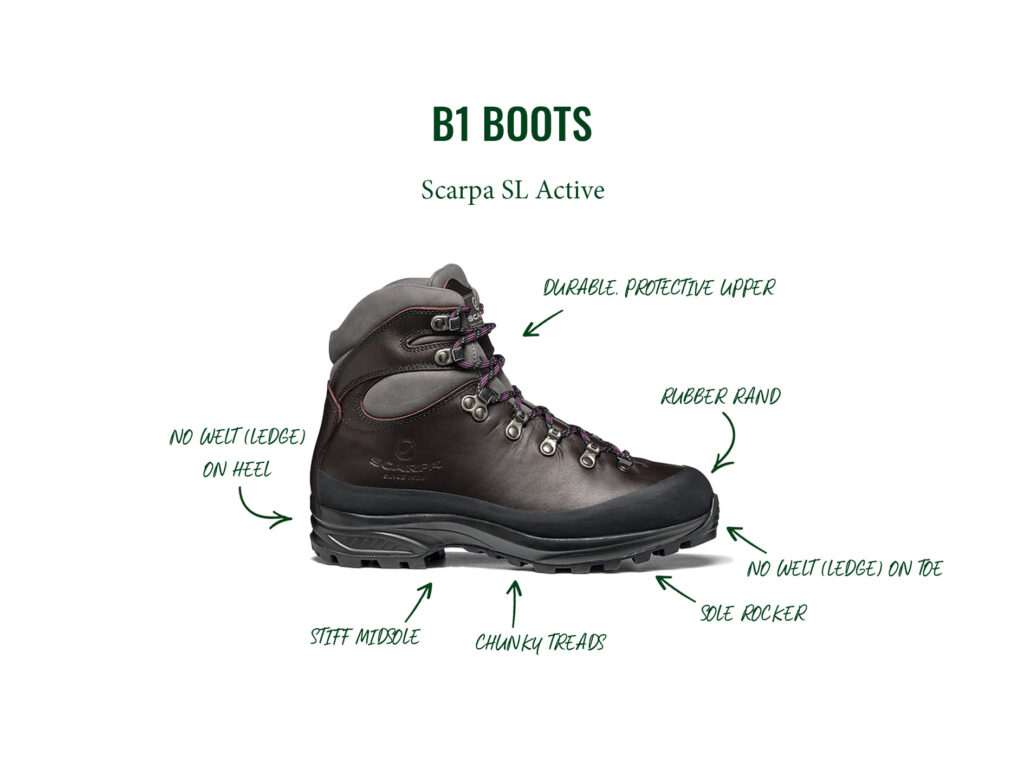
B2 boots
The midsole and upper of B2 boots are stiff and supportive, giving you ample protection in rocky or uneven terrain. However, they also have just enough flexibility to allow you to walk. B2 boots generally fall into two categories – faster and lighter or bigger and chunkier.
The faster and lighter ones have a flatter, more climbing-focused sole, aiming for activities such as summer scrambling over rocky climbing terrain.
With the ability to attach a mountaineering crampon for winter activities, the trade-off here is warmth. Chunkier and thicker boots work better for more winter-based activities. They still have a climbing sole, this time with a slight rocker, insulation and tougher uppers. You’ll also (almost) unanimously have a heel ledge that helps crampons fit securely.
These boots usually need pairing with C2 crampons to create an ideal setup for winter Munro-bagging and low to mid-grade climbing in snow and ice. A B2/C2 combination would also work well for summer Alpinism.
With the ability to attach a mountaineering crampon for winter activities, the trade-off here is warmth. Chunkier and thicker boots will be aimed for more for winter-based activities. They still have a climbing sole, this time with a slight rocker, insulation and tougher uppers. You’ll also (almost) unanimously have a heel ledge that helps crampons fit securely.
These boots are to be paired with C2 crampons, which would be ideal for winter Munro-bagging and low to mid-grade climbing in snow and ice. A B2/C2 combination would also work well for summer Alpinism.

B3 boots
B3 boots are the stiffest boots you can buy. They provide lateral and medial support for different actions and movements on technical terrain. B3-rated footwear best suits activities like advanced mountaineering, mixed climbing, and ice climbing. This rating also includes models with extra insulation for high-altitude missions.
Common features include heel and toe welts (ledges) that allow C3 crampons to fix onto the boot. These features help you to visibly identify a B3 boot compared to B2s, which only have the rear welt (ledge).
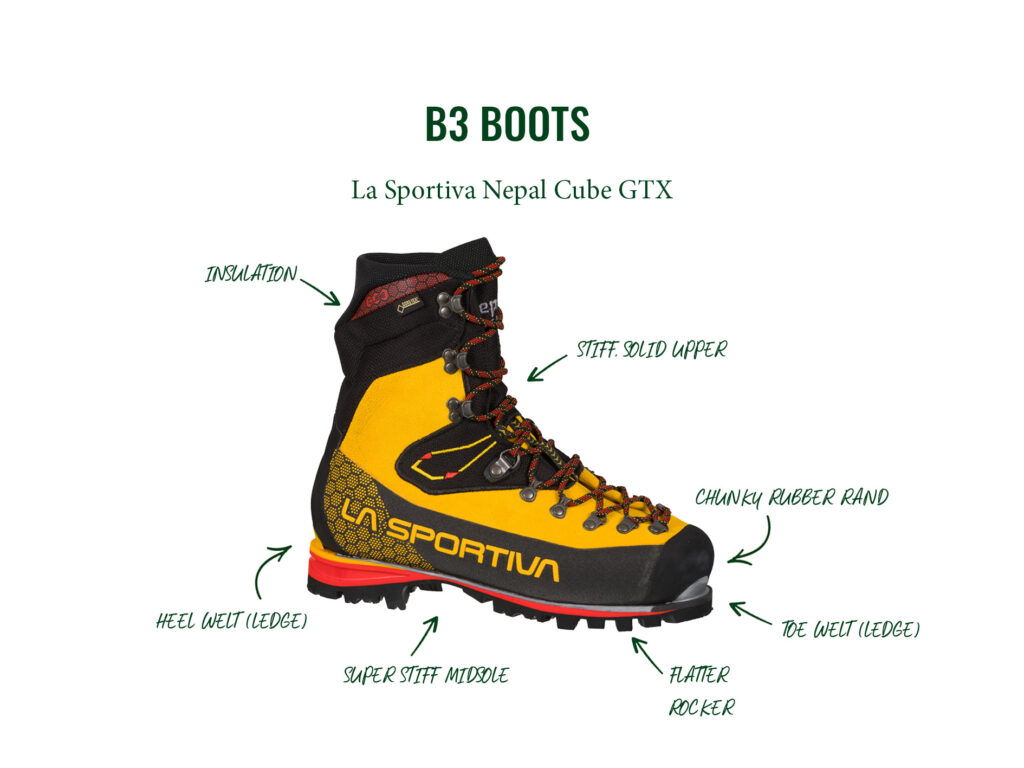
Next up are the Crampons. Again, we’ve broken down each rating to give you a clearer idea of this system.
Crampon Ratings
C1 crampons
C1 crampons are primarily used for walking, as the shorter, less aggressive points and more flexible binding systems do not lend themselves to climbing. Whether hiking Scottish Munros in Winter or trekking across Glaciers, they give you ample grip in snow and ice. These crampons usually have 10 points and a flexible bar in the middle to accommodate stiffer hiking boots, which still tend to be a little softer than full-on mountaineering boots. You’ll also notice a more flexible heel, toe baskets and connected straps that you can use to attach them.
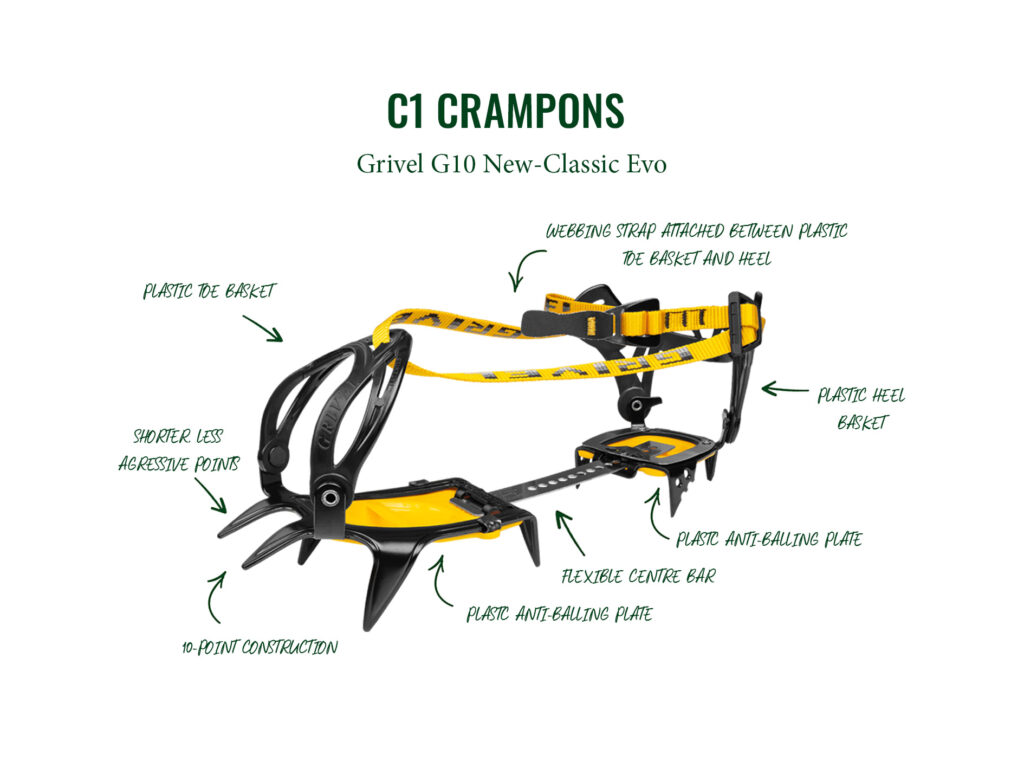
C2 crampons
C2 crampons usually have 12 spikes, which are more aggressive, to add extra traction in snow and ice. They’re designed for walking on more technical, icy terrain and climbing less advanced routes during the winter. Another noticeable visual difference on C2 crampons is that, unlike C1 crampons, they have specific clips on the rear. This clip attaches to the rear welt of most B2 boots, and is paired with a flexible, plastic toe basket and straps in between. The crampons will also flex less through the middle bar, lending themselves well to stiffer mountaineering boots.
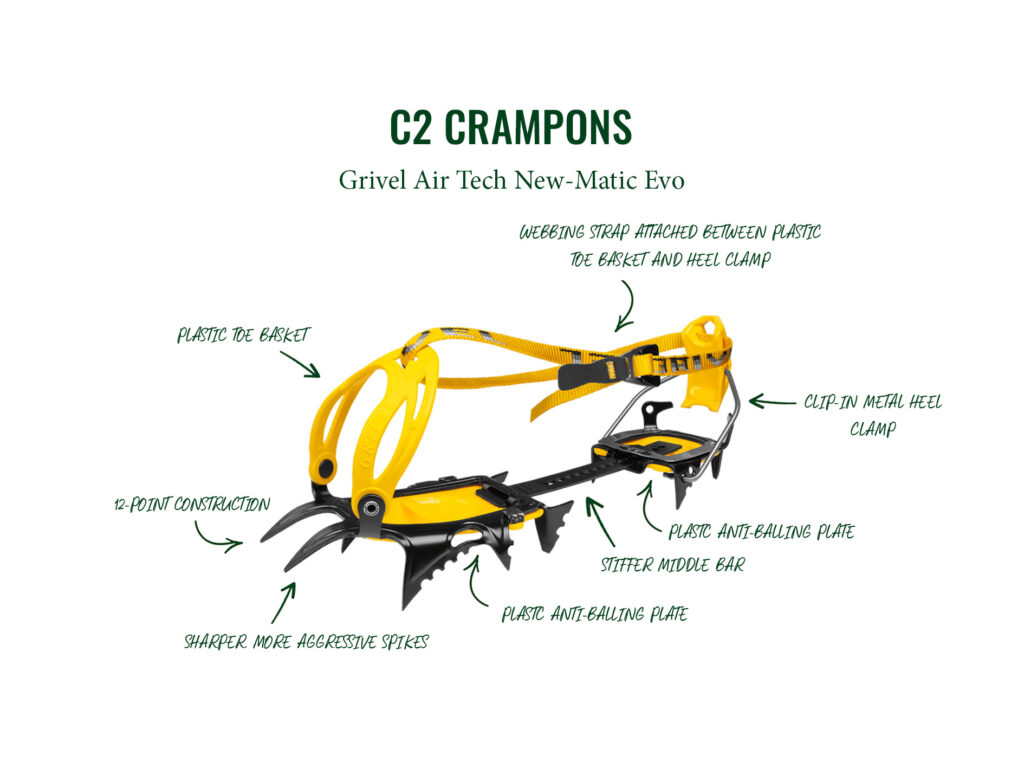
C3 crampons
A C3 crampon will take all the details from C2 crampons up a notch. The rear heel clip remains, but now you have a metal toe bail, rather than the plastic basket. You’ll notice B3 boots have welts on the front and rear to accommodate this, overall creating a secure fit on a stiff boot. These metal toe bails on the front provide more durability against solid ice and rock, which is safer than plastic for more technical ascents. Some crampons also allow you to reduce the number of points on the front to just one, for more precision on delicate terrain or climbing narrow cracks. C3 crampons are generally used for technical ice climbing.
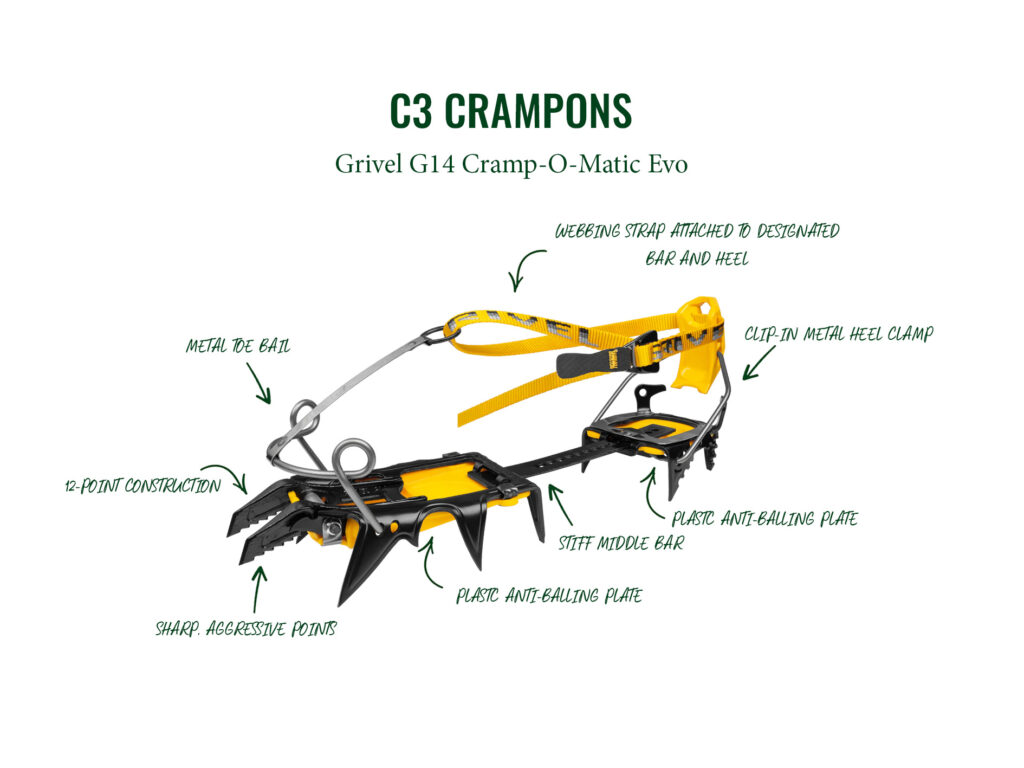
Adaptation systems
Some crampons are now being developed with ‘adaptation systems’ that allow you to transform a C2 crampon into a C3 crampon by, for example, changing the binding system. Some even have the ability to fit a different front section, one that is more aggressive, as your interests progress. This gives the user more versatility on different adventures and terrains, without spending double the price on multiple pairs. Keep an eye out for these coming into stock here shortly!
Crampons with cords?
You may also see crampons with a cord in the middle instead of a bar. A cord? Sounds a little ominous? This shouldn’t be a cause for concern; the cable is usually made with Dyneema, which is incredibly strong – so strong that it’s trademarked as the world’s strongest fibre. However, these lightweight crampons are only suited for use with rigid ski boots, for more technical levels of ski touring. Their lighter-weight construction makes them more packable and suited to consolidated snow, but not rocks and ice. These stiffer ski boots are needed to counterbalance the crampons’ flexibility – the last thing you want is your crampons popping from your boots mid-adventure!
Crampon Tips
A quick tip we’d offer to any crampon newbies is to be proactive. It can be easy to wait until you need them to wear them, but this can prove more difficult or even become dangerous if you get stuck on a snowy or icy patch with nowhere to rest and put them on. If you see a lot of snow or ice on the route ahead, put your crampons on before you reach that point. It’ll save you a lot of faff or stress and generally gives you the upper hand regarding safety.
Crampons and Microspikes at Trekitt
So, in a nutshell, the rating systems make it pretty easy to correspond your crampons to your activity and your boots. As long as you match the numbers, you’re pretty much good to go.
We stock a large variety of crampons, spikes and accessories here at Trekitt, including renowned brands like Petzl, Grivel, Nortec, Kahtoola and Black Diamond. You can shop our entire range of crampons by clicking here.
Looking for some new boots to match? We stock plenty of those, too! Check them out here.
If you have any questions, or need some further advice before you purchase, you can visit us in-store at our Hereford Service Centre, or speak with our friendly customer service team via telephone (01432 263 335) or email ([email protected]).

Leave a Reply